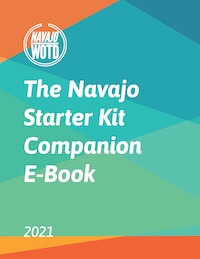nídiidááh
get up or wake up
Here are some ideas and phrases about getting up in the morning – some things you might hear at the very beginning of the day.
Opening your eyes
- My eyes are closed: Níínshch’il.
- I am opening my eyes: Dishghaał; or, shináá’ ąą’ áshłééh.
- My eyes are open: Shináá’ ąą’ át’é; or, díínísh’į́į́’.
Laying down
- I am laying down on my bed: Shitsásk’eh bikáa’gi sétį́.
- I just woke up: Áníídí ch’ééńdzid.
Waking up
- “Get out of bed”: Nídiidááh.
- “You wake up”: T’éénzííd.
- She woke me up: Náshidiiłt’e’; or, ch’ééh sinńsid.
Some of these phrases are intended to demonstrate how some ideas can be expressed in one word of Navajo.
It’s common practice, traditionally, to wake up and to put away bedding before the first light of dawn. The house or room should be neat, and if you’re running then you’re out the door to greet the sunrise.
